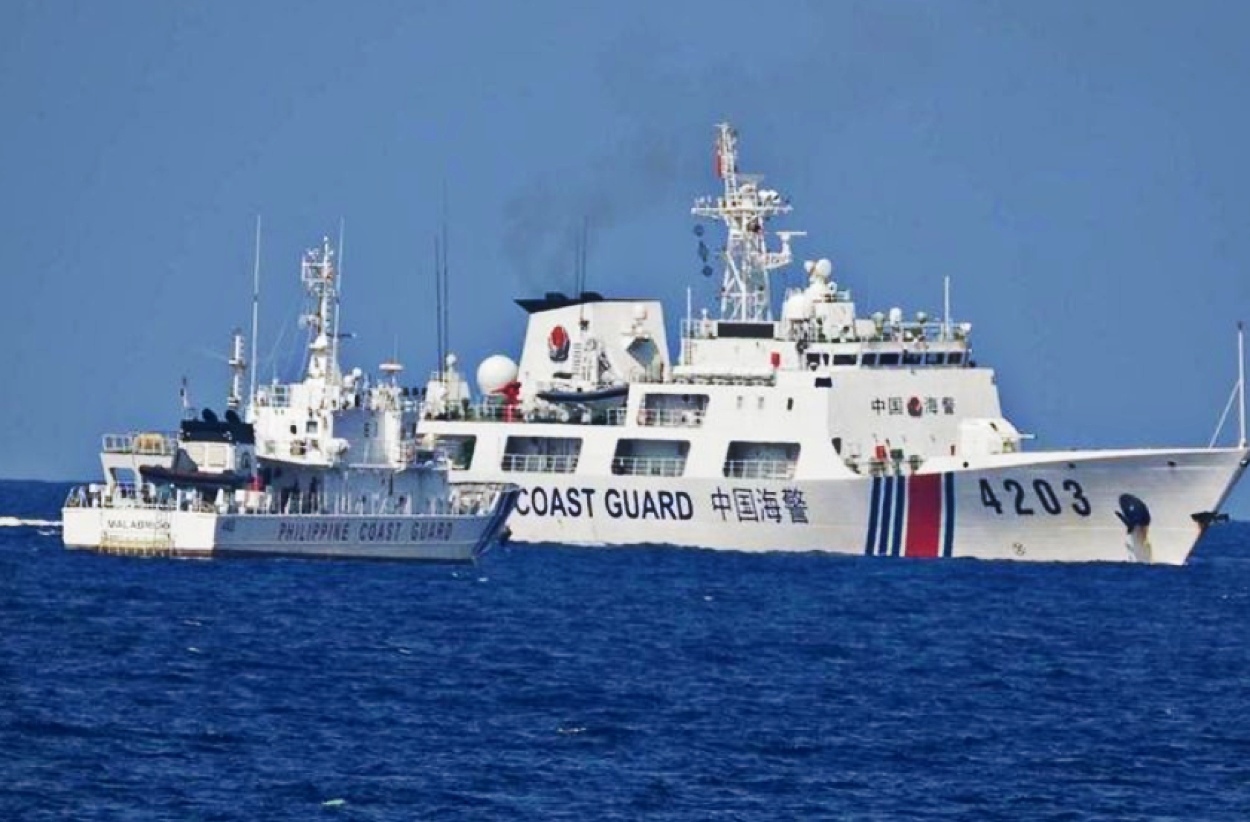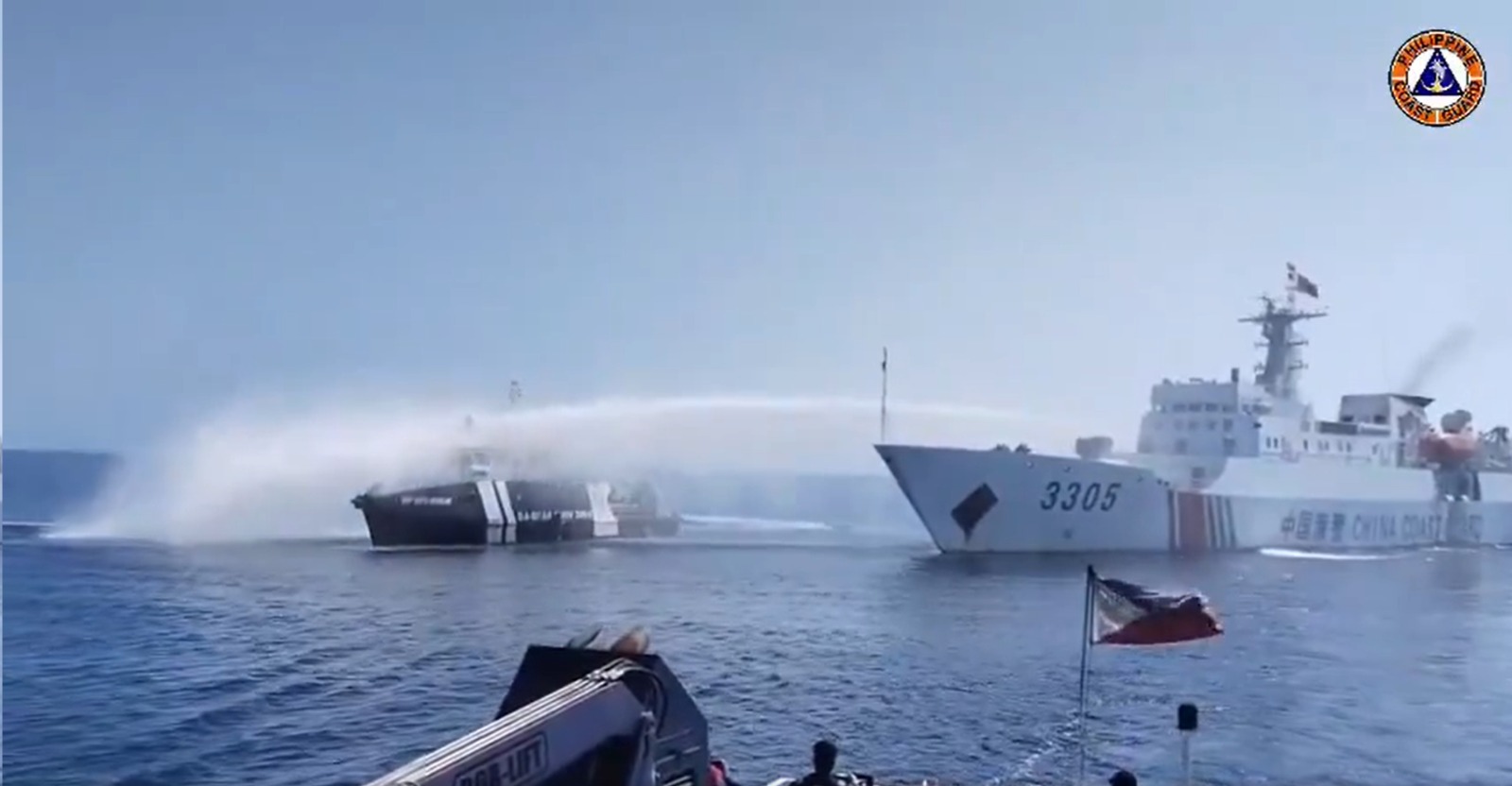By: Vaishali Basu Sharma
Tensions between China and the Philippines continue to sour due to a recent escalation in the South China Sea. Beijing has warned Manila against further provocations after an incident near a Philippine-flagged grounded warship.
Beijing and Manila have had a series of maritime run-ins, including water cannon use and heated verbal exchanges, which have triggered concern about a regional escalation.
South China Sea tensions have escalated in the past year as China has become increasingly confident in asserting its claims over waters also claimed by the Philippines and Japan, as well as over self-ruled Taiwan. This comes as Manila bolsters military ties with Japan and the US, rivaling Chinese influence in the region.
The Second Thomas Shoal has emerged as a potent flashpoint in the South China Sea, a submerged reef situated 194 km west of the Philippine island of Palawan and 32 km from China’s own Mischief Reef military base.
Second Thomas Shoal is where the Philippine Navy’s old landing ship BRP Sierra Madre was grounded in 1999 to reinforce Manila’s territorial claim. Manifesting President Xi Jinping’s belligerent stance, China’s navy and coast guard have intensified disruption against the Philippine resupply missions to the Sierra Madre’s garrison of Philippine marines, from deploying water cannons to ramming vessels.
At a press briefing, Chinese Defence Ministry spokesperson Wu Qian said, “China’s undisputed sovereignty over the Spratly Islands, including the Second Thomas Shoal and the surrounding Maritime areas, has a sufficient historical and legal basis.”
“We demand that the Philippines stop all acts of infringement and provocation. China will as always take firm and decisive measures to safeguard its territorial sovereignty and Maritime rights and interests.”
The Philippines has reacted by declaring that it is committed to maintaining its position at the Second Thomas Shoal and there will be no let up in resupply missions to Filipino soldiers on a grounded warship there.
A spokesperson of the Philippine National Security Council has said counter-measures announced by President Ferdinand Marcos Jr against “aggressive” actions by China’s coast guard will be “multi-dimensional” and not solely military in nature.
“Our commitment to maintain BRP Sierra Madre will always be there, so any attempt by China to interfere with resupply missions will be met by the Philippines in a fashion that protects our troops.”
However, the fact remains that the Philippines does not have the necessary naval capability to counter Beijing’s sea control tactics, which involve swarming to achieve temporary local control, mission-kill actions like water cannons, ramming, and now the use of helicopters.
One of the world’s busiest shipping routes, the South China Sea is strategically important and is rich in oil deposits and fishing stocks. Trillions of dollars of trade pass through it annually.
Beijing claims much of the sea as its territory and has set up military outposts with navy and Coast Guard vessels patrolling the area. Southeast Asian States, including the Philippines and Indonesia, dispute China’s sovereignty claims.
In 2016, an international Court in the Hague Ruled against China in a case brought by the Philippines that challenged Beijing’s claims in the area under Annex VII to the United Nations Convention on the Law of the Sea (the “Convention”).
The arbitral proceedings concerned the role of historic rights and the source of maritime entitlements in the South China Sea. The arbitral tribunal ruled overwhelmingly in favor of the Philippines, determining that major elements of China’s claim—including its nine-dash line, recent land reclamation activities, and other activities in Philippine waters—were unlawful.
Predictably, China reacted negatively to the ruling, maintaining it was “null and void.” Ignoring the ruling, China has instead insisted on its sovereignty claims, occasionally blaming US interests in the region for the continuing disputes in the South China Sea
Relations between Manila and Beijing have deteriorated under Marcos, who has taken a stronger stance than his predecessor, Rodrigo Duterte, against Chinese actions in the sea.
In March this year, delivering the Keynote Speech at the Lowy Institute Peace and Resilience Amidst Great Power Rivalries, Philippine President Ferdinand R. Marcos Jr. said, “It is unfortunate that despite the clarity provided by international law, provocative, unilateral and illegal actions continue to infringe upon our sovereignty, our sovereign rights, and our jurisdictions. This pattern of aggression obstructs our path towards Asia’s vision of the South China Sea as a sea of peace, stability, and prosperity.”
Last week, on March 28, Marcos issued a strongly worded statement vowing that the Philippines would not be “cowed into silence, submission, or subservience” by China.
These long-standing tensions have surfaced in the wake of leaders of Japan and the Philippines agreeing to work more closely together on security issues. Talks between the Philippines and Japan for a defense pact that would allow the countries to deploy troops on each other’s territory are “still ongoing.”

Late last year, the Philippines started using a Japanese air surveillance radar system to monitor maritime activities off its coasts. Speaking to Nikkei Daily, Japanese Prime Minister Fumio Kishida said that Tokyo, Washington, and Manila “will work together to proceed with trilateral cooperative projects,” including semiconductors, digital technology, and next-generation nuclear energy. In a show of solidarity, the Australian warship HMAS Warramunga arrived at the Philippine island province of Palawan, which faces the hotly contested waters.
Following up on what US officials are declaring an “ironclad” commitment to defending the Philippines against an armed attack in the South China Sea, President Joe Biden will meet Japanese Prime Minister Fumio Kishida and Philippines President Fernando Marcos Jr in Washington on April 11, 2024.

This will be the first US-Japan-Philippines trilateral summit, seen as the US’s outreach to counter China’s influence. In the coming week, the Philippines will also conduct joint naval drills with the United States, Japan, and Australia in the disputed South China Sea.
Amid the Southeast Asian nation’s maritime dispute with China, India’s External Affairs Minister S Jaishankar, visiting Manila, expressed support for the Philippines’ sovereignty and emphasized adherence to the UN Convention on the Law of the Sea (UNCLOS). He also expressed firm support for the Philippines in upholding its national sovereignty.
- Vaishali Basu Sharma is a strategic and economic affairs analyst. She has worked as a consultant with India’s National Security Council Secretariat (NSCS) for nearly a decade.




